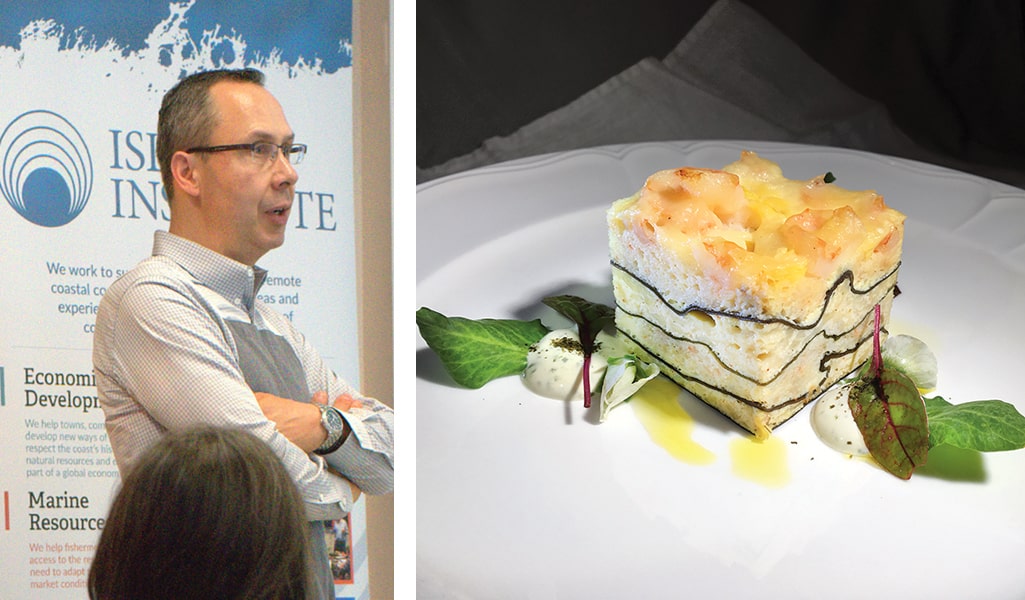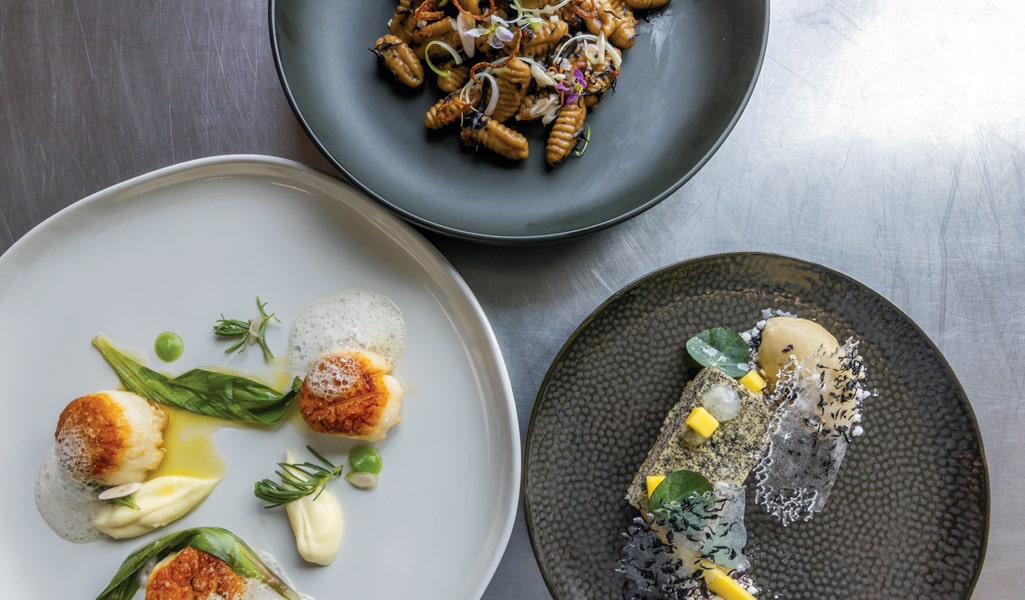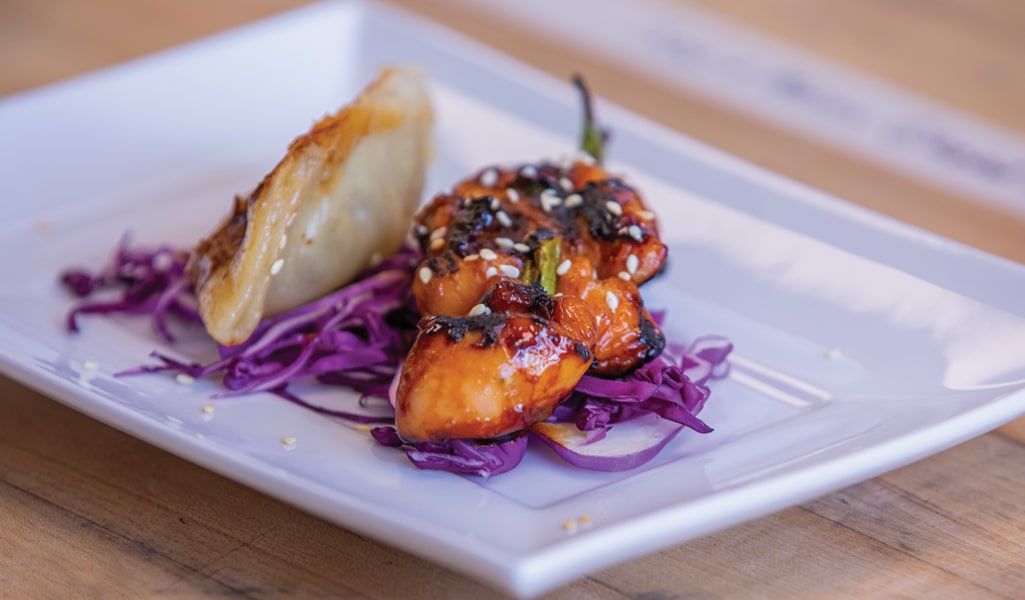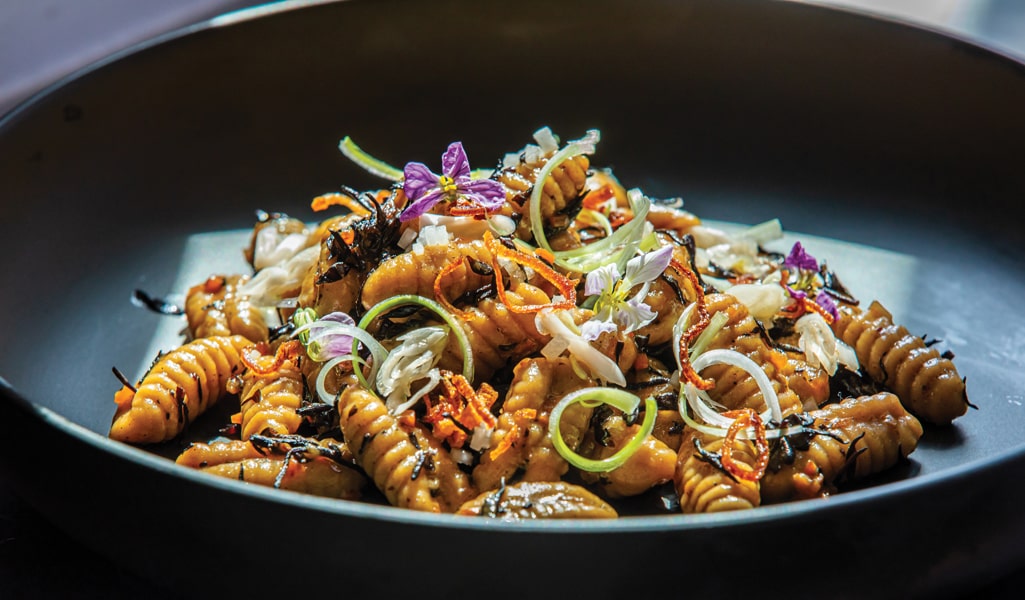JWU faculty and alumni on the opportunity — and necessity — behind the rise of the sea vegetable industry
Travis Bettinson’s ocean farming epiphany came in early 2019. He was listening to an episode of the Gastropod podcast, which featured a conversation with Bren Smith, cofounder of Greenwave, a nonprofit dedicated to teaching regenerative ocean farming to fishermen around the world.
Bettinson '10, who lived in Seattle at the time, had heard a little about the kelp industry from random mentions in national news outlets over the years, but this conversation was diff erent: Smith offered a deep knowledge of ocean farming, discussing the environmental value of cultivating seaweed and how well, for instance, seaweed co-cultured with shellfish — a food source that Washington led the nation in producing.
“Man, there have got to be farmers doing this,” thought Bettinson, who was running a catering service and working as a private chef at the time. “But the problem is that Americans don’t eat kelp at enough scale that the farmers can be supported.”
So Bettinson committed to change that dynamic. “I said right then that I’m going to do the research and development (R&D) and develop food products that can have a large impact.” As Bettinson dug into the challenges of the industry, he found that sea farmers often had to sell their products for compost or bioplastic research — “which is pennies on the pound.” For sea farming to flourish, someone would need to devise something that could actually entice American shoppers.
The more he considered the opportunity, the more sense it made. “It was this wonderful marriage of culinarily beautiful ingredients that have wonderful flavor, that are nutritionally dense, but also provides farmers — who are performing a wonderful environmental service — a market.”
In November 2020, after a year of R&D that surfaced everything from fermented seaweed hot sauces to sea vegetable soups, Bettinson launched Blue Dot Kitchen, where he currently serves as CEO and director of research development. In early 2022, the company launched its first product, Seacharrones, a crispy, crunchy kelp-infused snack, now available in more than 45 stores in the Pacific Northwest.
Bettinson’s passion for the promise of sea vegetables is not isolated. The commercial sea vegetable market is expected to grow to $37.8 billion by 2028, at a rate of about 10% per year, according to Grand View Research. Buzzy startups Akua and Umaro Foods have raised millions of dollars in startup funding with the promise of offering sea vegetable-based meat substitutes. For the past four years, Portland, Maine has been hosting “Seaweed Week,” an “annual food and drink festival celebrating the kelp harvest in Maine”; this year, the city also hosted the country’s first-ever “International Seaweed Conference USA.”
“Right now my mailbox is blowing up with seaweed,” says Associate Professor Branden Lewis, Ed.D., ’04, ’06 MBA, a specialist in international cuisines and sustainable food systems.
There’s someone looking to partner up to develop sea vegetable products and another company looking to get their sea vegetable products into the Johnson & Wales dining halls. “And my students buy it to use for their chef tables, because when they’re in my Culinary Sustainability classes, they research seaweed and they see why it’s sustainable.”
Those reasons are myriad. For one, it’s a zero-input crop that is grown underwater, so there’s no carbon footprint outside of distribution. “It also sequesters carbon dioxide at a much faster rate than land agriculture,” says Bettinson. “Additionally, as it’s growing, it’s constantly shedding bits of itself into the ocean. And 20 percent of the total growth of sea vegetables — and kelp in particular — gets left in the ocean for long-term carbon sequestration.” That absorption of C02, Bettinson notes, is doubly useful, as it helps to locally deacidify water systems — a necessity for the health of coral reefs, shellfish and many other elements of the ocean ecosystems.
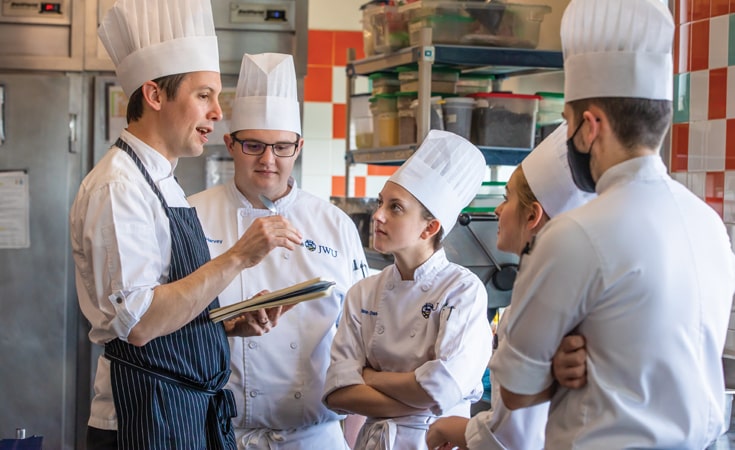
ABOVE: BRANDEN LEWIS WITH CULINARY SUSTAINABILITY STUDENTS PREPARING A MENU STARRING SEA VEGGIES.
“It’s health and nutrition, it’s people and planet, and it’s an economic opportunity that hasn’t really been fully exploited out here in the West,” says Bettinson, who notes that places like Norway, Finland and Japan are well ahead of the rest of the global markets.
But the rise of the sea vegetable industry is also a frontier borne of necessity, says Lewis. “The reason it’s drawing so much attention is because we’re really reaching Earth’s carrying capacity,” he notes. “As we do that — and as we’re seeing more and more land at risk for commercialization and not enough agriculture and too many people to feed, and we start looking at alternative sources of nutrition — then sea vegetables in the ocean are a big touch point when we talk about sustainability in academics.”
This constant chase of marine resources is part of New England’s economic origin story, says James Griffin, Ed.D., ’88, ’92 M.S., an associate professor in the Food & Beverage Industry Management department.
Consider the giant wooden codfish hanging in the House of Representatives chamber of Boston’s Massachusetts State House. “That’s because the economy of Massachusetts started because Gloucester was a commercial fishing port,” Griffin notes. “The first folks who came to Gloucester were from Gloucestershire, England — and the only thing they could do was fish.”
An abundance of varying cod species supported the industry for generations until the 1980s, Griffin says, when the industry collapsed due to overfishing. Subsequent regulations forced consideration of alternatives, which led to the expansion, for instance, of the lobster industry. “It was a constant question of ‘What other species, what other fisheries can we look at?’” says Griffin. “Long story short, the current view on sustainability and exploring new ocean resources is born of that spirit — a spirit of having to look constantly at this wild resource and say, ‘Hey, if there was economic benefit or nutritional value from this, and it’s now in decline, what else is there?’”
Today, that mindset has led to an unexpected resource. “I’ll tell you this: The last thing on earth we ever thought we’d be looking at is seaweed,” says Griffin.
And he has taken a very thorough look. In 2018, he worked with the Island Institute, a nonprofit focused on addressing the environmental and socioeconomic challenges of Maine’s island and coastal communities, to research how the state could increase the economic viability of sea vegetable products so that lobster producers could cultivate them in the shoulder seasons.
“It’s not a lot of money; I call it gas money,” says Griffin. “But if we could develop this fishery, this seaweed production, and cultivate and grow it, lobstermen might be able to generate enough money in the shoulder season to the opening of lobster season to perhaps pay for their fuel for the season.”
It’s health and nutrition, it’s people and planet, and it’s an economic opportunity that hasn’t really been fully exploited out here in the West.TRAVIS BETTINSON '10
Eat Your (Sea) Vegetables
The resulting report was built on two fundamental questions: What innovative products could be developed that have commercial viability? And what do consumers really think of this stuff?
The research team developed 10 different products, everything from simple salads to sea cup ice cream to baked goods, and then hosted a tasting panel to get feedback. “In the end, the sea vegetables we used were easily integrated into a range of products,” says Griffin. “And consumer acceptance was universally positive. In other words, people were really willing to eat this stuff.”
The results not only provided the Island Institute with valuable insight into the opportunity for sea vegetable cultivation that it could share with its communities of lobstermen, but were so convincing that his fellow researcher, Briana Warner, left her job at the Institute to head up Atlantic Sea Farms, a seaweed company in Maine. “It’s now one of the fastest-growing seaweed growers in the state,” says Griffin. “And the industry has grown around 10 to 12 times since we did the report. So it’s really blossoming now.”
For Branden Lewis, talk of sea vegetables isn’t just dominating his inbox, but his classroom too.
His Plant-Based Cuisine course, part of a Culinary Sustainability minor within the Sustainable Food Systems major, explores all plant cuisines. Courses include Cooking from the Farmstand, Growing for the Menu, and Sustainability in the Culinary Kitchen. Health & The Harvest is a senior capstone lab where students marry culinary skill to sustainability and health advocacy. Plant-based cuisine explores the preparation and marketing of plant-based foods in cuisine concepts around the world. The Sustainable Food Systems program features courses that incorporate locally-grown and-harvested ingredients. Given Rhode Island’s geography, sea vegetables are local stars.
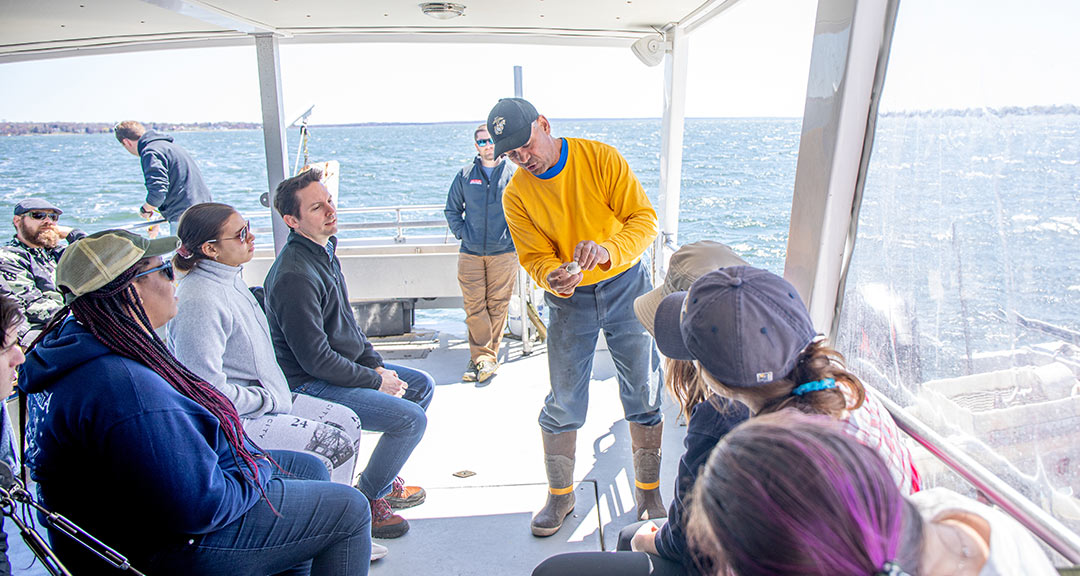
Classroom at Sea
Associate Professor Branden Lewis, who oversees the university’s Sustainable Food Systems program, took his class out on Narragansett Bay, where they learned to quahog from local expert Jody King.
There’s a sunomono seaweed salad, a popular Japanese dish. There’s kombu, an edible kelp which Lewis uses to make a vegetarian fish sauce, and lots of dashis, which are soup stocks. He’s also a big fan of furikake, a rice seasoning featuring seaweed. Toasting nori, the iconic sushi wrap, over a burner results in an aromatic crunchy and salty flavor. There’s agar-agar, a gelatin made of refined seaweed, used to make things like mousse or panna cotta. “If you want to have a panna cotta that’s vegetarian, the only way to do that is to use something like agar-agar.”
There’s also an abundance of different extracts that can be made from various seaweed species, says Lewis. “Carrageenan”—an extract from red seaweed — “has three different parts of the seaweed that you can extract to get iota, kappa and lambda carrageenan — all with different properties.”
All of these iterations can create an expansive menu, says Lewis. “It’s not something the West has really dived into yet — and it’s an opportunity.” But some American culinary stars have taken notice. Chicago-based Karen Urie Shields ’00 and her husband John Shields — finalists for “Best Chef” in this year’s James Beard Awards — have won praise for their sea vegetable creations, including sea lettuce cookie amuse-bouche.
Chef David Kinch ’81, ’14 Hon., owner of three Michelin stars for his California restaurant, Manresa, created an iconic dish called the “Tidal Pool,” which inspired a New York Times writer to refer to Kinch as “the savior sent to bring California cuisine into the 21st century.” The incorporation of sea vegetables into the dishes of marquee chefs is critical to the growth of the industry, says Griffin. “When we look at product expansion, going from trend to ubiquity, the beginning of that process comes with thought leaders and innovation. And for me, at least in the communities I watch, it’s often a very thoughtful, influential chef who is driving that.”
When we look at product expansion, going from trend to ubiquity, the beginning of that process comes with thought leaders and innovation.ASSOCIATE PROFESSOR JAMES GRIFFIN, ED.D., ’88, ’92 M.S.
The incorporation of sea vegetables into the dishes of marquee chefs is critical to the growth of the industry, says Griffin. “When we look at product expansion, going from trend to ubiquity, the beginning of that process comes with thought leaders and innovation. And for me, at least in the communities I watch, it’s often a very thoughtful, influential chef who is driving that.”
He describes this impact to students as a pebble hitting the water. “As that ripple expands, it has to become more approachable, easier to lift and understandable. And usually, the pebble hitting the water is occurring in an urban area where there’s a lot of food interest and a concentrated number of people who can get into that.” Let’s say a trend starts in New York City, with its population of 8.5 million. “Then maybe there’s 50,000 people who become food obsessed with this weird seaweed thing — which is a tiny percentage of New York, but it’s 50,000 people.”
That kind of pickup builds momentum, says Griffin, and the ripple then spreads. From New York City, it heads to smaller urban areas like Boston. Then it makes its way to places like Hartford and Providence. And just as important as making it to menus, he notes, is making it to store shelves. “Supermarkets are watching these thought leaders, and they’re acting quickly to get their suppliers to come up with ideas and options that they can roll out, too.”
That kind of pickup builds momentum, says Griffin, and the ripple then spreads. From New York City, it heads to smaller urban areas like Boston. Then it makes its way to places like Hartford and Providence. And just as important as making it to menus, he notes, is making it to store shelves. “Supermarkets are watching these thought leaders, and they’re acting quickly to get their suppliers to come up with ideas and options that they can roll out, too.”
And, of course, that consumer shopping at the supermarket has to be motivated not just by curiosity, but by an environmental consciousness. “As we intensify our growing practices, we are using GMO products and monocropping,” says Lewis. “And people are rejecting that. As they’re rejecting that, they’re looking for more wholesome foods, and sea vegetables seem to fit that category in a lot of ways.”
That is the endgame Bettinson envisions. “We’ve always wanted our products to be the spearhead for people who knew that seaweed was healthy,” he says. “People who understood maybe the environmental impacts of it, but had never really adapted to the flavors of seaweed.”
Mainstreaming those flavors could have its own ripple effect. “We really want to be the brand that brings more U.S. consumers into eating seaweed so that, down the line, when all these other producers are putting out products and all these chefs are making dishes, it’s no longer an exotic thing,” he adds. “It’s an ingredient that’s included in the food. And it’s just what people like.” JWU
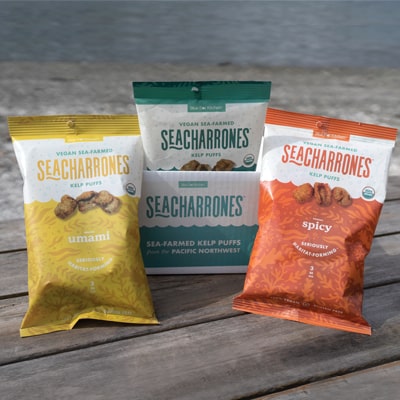 Wet Lab
Wet Lab
What does an ocean farm look like?
Working out of a five-acre site in one of the Puget Sound’s main basins, Blue Dot Kitchen employs the prevailing method of sea farming: 3D, vertically integrated farming. “Essentially, you anchor two buoys into a subtidal zone of water, separated by 500 yards,” says Bettinson.
Between the buoys, they string a line that has been soaking in a bath of nutrients that attracts and feeds kelp spores, letting the plants latch and grow; sugar kelp can grow up to seven inches a day. “At harvest time you just have to pick up the line to hand harvest it.”
Getting from seaweed to Seacharrones requires trucking to a dehydration facility. “We want to make it shelf stable,” he says. “Seaweed can spoil relatively quickly if it’s not stored well, and lose a lot of its quality.” For the Seacharrones, the kelp is then powderized, later mixed with rice and sorghum, and popped into their kelp puffs. “And then from there we toss it with different topical flavors,” says Bettinson. “And we can adapt that as needed to what our customers want.”
